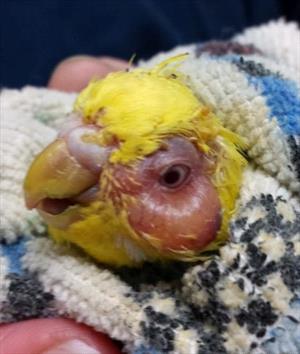Distended Infraorbital Sinuses in a Budgie

Photo Courtesy Dr. Michele Pietrzak
What is Psittacosis?
Psittacosis, also known as parrot fever, ornithosis, and avian chlamydiosis, is a bacterial infection found in at least 465 species of birds worldwide. It is highly contagious among birds and can spread to people. Any pet bird can get this disease, but cockatiels, budgies, and parrots are the most commonly affected companion species. Psittacosis may kill more than 50% of birds it infects, but ultimately the risk of death depends on such factors as the species and the health of the bird.
What Causes it?
Psittacosis is caused by Chlamydia psittaci, a bacterium that enters, multiplies in, and destroys cells of the infected bird. C. psittaci may target cells throughout the bird’s digestive system, respiratory system, or entire body.
How is Psittacosis Transmitted?
Infected birds may shed C. psittaci in their droppings, saliva, mucus, feather dust, and eye/nasal discharge. Healthy birds may then inhale this bacteria in airborne particles, such as dust from dried droppings and feathers. Birds may also ingest C. psittaci from contaminated food, water, perches, and toys. While these are the most common modes of transmission, blood-sucking insects such as lice may also spread the bacteria among birds. A mother bird may also transfer C. psittaci to her chicks before or after they hatch.
What are the Signs?
- Discharge from the eyes and nose
- Swollen, watery and crusty eyes
- Yellow or green droppings
- Depression
- Reduced vocalization
- Reduced appetite
- Weight loss
- Weakness
- Ruffled feathers
- Trouble breathing
- Fever
- Diarrhea
- Excessive urination
- Rare signs: trembling, seizures and head twisting
Not all birds infected with C. psittaci appear sick. These birds are called carriers. They appear healthy but may become ill and shed the bacteria during times of stress (e.g., battling another infection, changing diet, or living in a crowded environment). Species including budgies, cockatiels, and cockatoos are more likely to be carriers, while lorikeets, canaries, and rosellas are more likely to become sick and show symptoms.
How is Psittacosis Diagnosed?
Signs of psittacosis are similar to those of many other diseases. Therefore, your veterinarian may do blood tests, take X-rays, or run some additional specific tests to more definitively diagnose psittacosis. Those specific tests include measuring antibody levels in the bird’s blood and testing for C. psittaci in swabs from the bird’s mouth, eyes, and vent. The vent is the shared opening of the urinary, digestive, and reproductive tracts.
How is it Treated?
Doxycycline is the antibiotic of choice for combating C. psittaci. However, it may not completely eliminate C. psittaci from the body, leaving the bird a seemingly healthy carrier that could spread the disease to other birds or become ill again under stressful conditions. To lower this risk, a veterinarian may prescribe doxycycline for 2-8 weeks; the usual duration is 45 days. This medication may be given by mouth, injection, or in food/water. The veterinarian will decide the best method for your bird based on its species and the severity of disease. If the bird is given doxycycline by mouth, its calcium intake from such sources as mineral blocks and cuttlebone should be reduced because calcium may limit the absorption of doxycycline.
If the bird is suffering from a severe form of psittacosis, your veterinarian may also provide fluids, heat, and other additional treatments to relieve the symptoms.
How can Psittacosis be Prevented in Birds and Humans?
Birds should always be fed a healthy diet and live in clean, uncrowded, and non-stressful conditions to reduce the risk of illness. Any new bird should be examined by a veterinarian, tested for C. psittaci, and quarantined for 30 days or more. An infected bird should be isolated and treated. Anything that has been in contact with the infected bird should be thoroughly cleaned and disinfected. Because psittacosis can spread from birds to humans, you should always wear protective gear such as a mask, gown, eyewear, and gloves when interacting with the infected bird. It is also important to wash your hands after each interaction.
What is the Prognosis?
The mortality rate of psittacosis can reach upwards of 50% in birds. However, this percentage depends on such factors as the species and health of the affected bird and how early the disease is caught and treated. If psittacosis is caught early and treated properly, the prognosis may actually be quite good. Stressful conditions or simultaneous infections may result in more severe disease and a worse outcome. It should also be noted that although treatment may make the bird feel better, the bird may remain a carrier of C. psittaci. This means the bird could become sick with psittacosis and spread it to other birds at some point in the future.